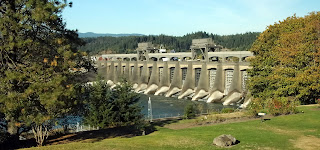
Pine Mountain News
Spring has sprung with full force on Pine Mountain.
Everything is green and the wildflowers are beginning
to bloom. It is a time to mend the fences and prepare
the ranch for spring and summer.
The greenhouse and the fish in the aquaponic tank
survived the winter and are doing well.
Poem of the Week

Friday Night in the City of Roses
by emily d stine
and the locals are listless under-
neath their tortoise shell eyes.
Inside, in gray low lights
and cigarette clouds
new age music wafts
lazy-like over to the crowds.
In studio lofts, art galleries and bars,
put on emphatic facade
'cause we're all gonna be stars.
Clutching pints, the perfect accent
for those black fingernailed hands
of the hipster rockstar tattooed fans.
It's Friday night in the city of roses,
the river's eerie outside, it's bubbling,
for the sea, but tonight the babble's
inaudible
over the band and the Friday night scene.
Story of the Week
The Columbia River
by G Smith
The Columbia river at 1243 miles is the longest river in
the Pacific Northwest. It drains an area roughly the size
of France. The Columbia forms much of the border
between Oregon and Washington and drains 7 states.
It is the 4th largest river in the United States.
The Columbia begins at 2690 feet ( 820 meters) above
sea level in the Rocky Mountain trench that forms the
border between British Columbia and Alberta in Canada
. The river flows northwest for the first 200 miles then turns
sharply south at the north end of the Selkirk mountains.
The Columbia turns west at the Spokane river then South
at the Okanagan river then southeast at the Wenatchee
river forming a big C. The river then heads west at the
Washington- Oregon border. The River then becomes
the Washington -Oregon border for the final 309 miles
to the coast.
During the last ice age about 15,000 to 10,000 years ago,
the Columbia took a more direct course through the
big c area when the ice dams on ancient Lake Missoula
would break sending the entire lake down the Columbia river.
When the flood was over the direct route formed a dry river
bed. This dry river bed was called a Coulee. Grand Coulee
dam was built during the depression forming lake Roosevelt
opened in 1942. It is the largest dam on the Columbia at
5223 feet (1586 meters) wide and 550 feet ( 168 meters high).
Normal water height is 380 feet ( 115 meters). In 1951
with the addition of Dry Falls dam and North dam, Banks
lake was formed in the dry coulee valley above lake Roosevelt.
Twelve 14 inch pipes and pumps lift water 280 feet from
lake Roosevelt into lake Banks forming a 27 mile long lake
for irrigation of the surrounding area. Six of the pumps can
be reversed and turned into turbines during peak electric
demand times. Total power output of the Grand Coulee
dam with 33 Turbines is 6809 megawatts. The biggest
problem with the Grand Coulee dam is that salmon can
not get by the dam. This keeps the salmon in the last 243
miles of the river instead of 1243 miles like they once roamed.
The Columbia continues through Gorge Amphitheatre,
Priest Rapids dam, then the Hanford Nuclear Reservation.
The Hanford Reservation is the only untamed part of the
Columbia that is left.
The Snake river and the Yakima river join the Columbia
and the river turns sharply west at the Washington Oregon
border. The Columbia becomes the border for the two states
for the final 309 miles of its journey. The Columbia reaches
the Dalles. Between The Dalles and Portland, the Columbia
cuts through the Cascade mountains forming the breath taking
Columbia River gorge.
The gorge is 4000 feet at the deepest part and 77 streams
flow into the gorge before the Columbia reaches the ocean.
Many of these 77 streams form spectacular water falls as
they deposit their water load into the gorge.
The last dam of the 14 dams on the Columbia before the
Pacific is the Bonneville dam. This dam has an island in the
middle and 2 hydroelectric dams one on each side of the island.
The Bonneville dam also has a lock for river traffic and fish
ladders to help the salmon navigate the river.
At Portland a few miles from the Pacific, the Columbia
turns to the north and slows dropping a load of silt. It then
turns west again and joins the Pacific. The last turn keeps
the Columbia from forming a delta at the ocean.
Pine Mountain Evening
It is evening once more at the Pine Mountain
Ranch. We have just finished dinner and are
gathered in the family room to watch a nature
movie on TV.
I am seated in my favorite reclining chair and
have fresh baked sugar cookies with this week's
sample coffee from http://www.coffeefool.com
Tonight my flavor is Dutch Chocolate. This American
roast coffee is a chocolate lover's dream with just a hint of
coffee flavor to round it out.
My coffee and cookies are finished now and the movie is over.
It is time for bed. Good night all, see you in 2 weeks.
resources
http://en.wikipedia.org/wiki/Columbia_River
googlef90539838d7357c8.html







No comments:
Post a Comment